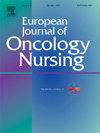Creative methods to explore children's experiences of gastrostomy and nasogastric tube feeding during allogeneic bone marrow transplant
IF 2.7
3区 医学
Q1 NURSING
引用次数: 0
Abstract
Purpose
Children undergoing bone marrow transplant experience severe gastrointestinal toxicity. Most become unable to eat, drink and take medications orally putting them at risk of malnutrition and clinical complications. To meet these demands most children require a feeding tube. This study explored children's experiences of having a nasogastric or gastrostomy tube.
Methods
During this qualitative component in a mixed methods study, children completed scrapbooks as a creative method which acted as stimuli during two interviews: on admission for transplant and 1–2 months post-discharge. Parents helped their child during interviews where needed. Interviews were thematically analyzed.
Results
Six children (aged 5–11) who had a nasogastric tube, three a gastrostomy were interviewed. Five themes are presented. Either tube was uncomfortable at first and required adjustments to daily living, but children adapted quickly. Children wanted choice of tubes and liked being involved in decision-making. They felt both tubes were an asset, particularly to administer medications.
Conclusions
Multidisciplinary team support was crucial to the acceptance of either feeding tube. Even though tube feeding can seem a burden, children were appreciative of its importance to receive medicines and nutrition and recommended either tube to other children going through transplant. Having a choice of tubes was important as they appreciated one option might not suit all. Ensuring the child's voice is heard through research is paramount to providing optimal healthcare but can be challenging in practice. Building rapport with families and support from a multidisciplinary team were essential in enabling children to share their experiences.
创新方法探讨儿童同种异体骨髓移植中胃造口及鼻胃管喂养的经验
目的:儿童骨髓移植会出现严重的胃肠道毒性。大多数人无法进食、饮水和口服药物,这使他们面临营养不良和临床并发症的风险。为了满足这些需求,大多数孩子需要喂食管。本研究探讨儿童接受鼻胃管或胃造口管的经验。方法在混合方法研究的定性部分,儿童完成剪贴簿作为一种创造性的方法,在两次访谈中作为刺激:移植入院和出院后1-2个月。父母在面试时帮助他们的孩子。对访谈进行主题分析。结果6例儿童(5 ~ 11岁)行鼻胃管,3例行胃造口术。提出了五个主题。两根管子一开始都不舒服,需要适应日常生活,但孩子们很快就适应了。孩子们想要选择管子,喜欢参与决策。他们觉得这两根管子都很有用,尤其是在给药方面。结论多学科团队的支持对两种饲管的接受至关重要。尽管管饲似乎是一种负担,但孩子们意识到接受药物和营养的重要性,并向其他接受移植的孩子推荐任何一种管饲。有一个选择的管道是很重要的,因为他们意识到一个选择可能不适合所有。通过研究确保儿童的声音被听到对于提供最佳医疗保健至关重要,但在实践中可能具有挑战性。与家庭建立融洽关系以及多学科小组的支持对于使儿童能够分享他们的经历至关重要。
本文章由计算机程序翻译,如有差异,请以英文原文为准。
求助全文
约1分钟内获得全文
求助全文
来源期刊
CiteScore
4.40
自引率
3.60%
发文量
109
审稿时长
57 days
期刊介绍:
The European Journal of Oncology Nursing is an international journal which publishes research of direct relevance to patient care, nurse education, management and policy development. EJON is proud to be the official journal of the European Oncology Nursing Society.
The journal publishes the following types of papers:
• Original research articles
• Review articles

 求助内容:
求助内容: 应助结果提醒方式:
应助结果提醒方式:


